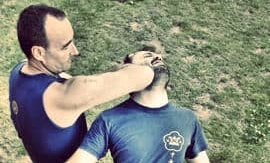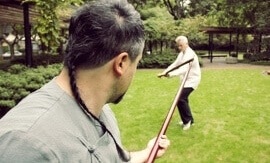
THE TITLE OF THIS ARTICLE IS PROBABLY FAMILIAR TO NEARLY ALL WHO READ IT, BEING PART OF A FAMOUS QUOTE FROM THE LATE SIFU WONG SHUN LEUNG, A STATEMENT HE MADE TIME AND TIME AGAIN DURING HIS MANY YEARS AS AN INSTRUCTOR AND MENTOR TO SEVERAL GENERATIONS OF STUDENTS.
These days, as more people are drawn towards the WSL Ving Tsun Kuen Hok approach, many who really haven’t fully absorbed his ideas, or who have only a superficial understanding of his methods, take that now famous quote out of context to justify their often contradictory ideas, somehow believing that, by doing so, it will validate what they are doing.
If one reads the full version of the quote, as opposed to simply paraphrasing it, his meaning becomes clear, and it most definitely does NOT indicate he was advocating the use of techniques or methods outside of his clearly defined and road-tested system. As he stated precisely, “Styles have different concepts and objectives. With Wing Chun, we want to attack our opponent in a very direct and savage manner. Other styles will contradict this objective by attempting non-direct attacks. If we combine them (different styles/methods) with Wing Chun, our objective can become confused in the heat of the fight. We will be less effective.”
Those who have, in recent times, claimed they are “improving upon” WSL Ving Tsun Kuen Hok by adding ideas foreign to Wong Shun Leung’s stated methods, or who claim they are following his philosophy to the letter by adding ideas and techniques he never condoned, based solely upon their complete misinterpretation of his words, are missing the point of his actual meaning. In following this approach, they are NOT improving the system, but complicating it and making it far less efficient than it was, to begin with.
It is worth looking closely at his original statement, from which the title of this article was derived: “Wing Chun is very logical. As long as the art remains logical, it doesn’t matter what you call it, and it doesn’t matter if what you are doing isn’t ‘Wing Chun’ as such. If it’s logical, if it WORKS, then you can use it to make your art your slave, not your master. However, you have to be careful about mixing Wing Chun with other styles. A man from the North and a woman from the South can have a baby, but whether a man and a dog can have a baby, I’m not so sure!”
While adding a little of his trademark dry humour in that last line, his meaning should come across loud and clear. He was never advocating the practice of mixing styles, believing that mostly, they do not complement each other and are not likely to work under real pressure.
On another occasion, when speaking on the same topic, Wong Sifu made the following statement: “It is never a case of correcting one’s system, but improving one’s self. Say you play chess with a very good chess player. Even if he wins, he will have had to sacrifice some pieces along the way, but he knows that the sacrifices were necessary to ensure the victory. Some people, when they get hit, feel that they have been hurt and that their particular Gung Fu system is no good. In Wing Chun, if this happens (that we get hit), we don’t think in these terms. Instead, we’ll ask ourselves ‘What have I done wrong?’ or ‘What is it that I can’t do?’ Our question isn’t ever ‘How does Wing Chun work?’ but ‘How can I make Wing Chun work for me?’ In other words, don’t be bound by Wing Chun, or any other system for that matter, make it work for you. Be the MASTER, not the SLAVE.”
Wong Shun Leung was adamant there was little left to improve in the Wing Chun system, and that it would always be more of a question of how we can find better ways to train and improve our use of Wing Chun, rather than changing or adding to it. He deplored the idea that we should add things to the system because of some perceived notion it was lacking anything. Unlike many before or since, he had taken the system out into the Pavement Arena and road tested it under real conditions. His understanding of Wing Chun wasn’t theoretical—it was battle tested! The knowledge he gained in these celebrated Beimo matches was brought back to his teacher, Sigung Ip Man, and discussed at length to extract the best from the system and to find better ways to train and apply it.
To think any of us, who lack the experience and skills of both Ip Man and Wong Shun Leung, can somehow come up with a “better way” by simply adding “new tools” into the mix, smacks of arrogance and is fraught with danger. Combat involves specific tools for specific ranges and situations, and if the wrong tool is applied, the risk of defeat and injury is high. The range at which Wing Chun is designed to operate most efficiently is up close, in-your-face up close!
The main goal of Wing Chun, as stated by Wong Sifu, is to attack the opponent aggressively and directly, so how does the introduction of grappling and throwing, when direct strikes are the better option, make for an improvement in the system? Wing Chun is a science-based system that works because of its consistent and logical concepts. To tinker with a balanced system, such as this, is akin to adding a fifth wheel to a Ferrari; it won’t make it go faster and it won’t improve the handling.
How does the introduction of round punches and kicks improve the directness of a straight attack and shorten the time taken to deliver that attack? Why teach students to use an elbow action when a punch can be delivered with less risk and more control of the opponent? Adding such things, just because you cannot make your Wing Chun work as is, is illogical. You are just making things more complicated and less efficient—not improving anything.
It would be far better to look at what you cannot do well and find a better way to train those concepts until you CAN make them work under pressure. Looking for a “magic bullet” or a fancy new method isn’t the answer to the problem. Quoting Wong Shun Leung to justify your methods is dishonest and ridiculous. If it’s such a great an idea, man up and take credit for it!
Don’t get me wrong and don’t get Sifu Wong Shun Leung wrong, either. I’m not, and he wasn’t, saying you couldn’t step outside the box if a situation calls for adaptation when things are not going well. The Biu Ji form is telling you exactly that approach, whereby so many of the “rules” of the system are contradicted and ignored within the concepts and techniques to be found in that form. However, what is the essential theme of the Biu Ji form? It acknowledges that things can go wrong and that, sometimes, you’ve just got to “bend the rules” and adapt to the moment. It teaches us exactly what Wong Sifu is saying: Don’t be a slave to Wing Chun!
However, like the now famous quote, Biu Ji is NOT telling us to abandon Wing Chun or to change the system; just be the MASTER of the moment and do what needs to be done to solve the problem at hand. It isn’t telling us to modify the forms, add techniques, or incorporate ideas from other systems; it’s telling us exactly what Wong Shun Leung was trying to tell us when he made the quote: Attack directly and aggressively and always try to hit your opponent, not play a game with them, but if you find that something cannot be used as desired, be open to adapting under pressure, and then afterwards go back and ensure that such problems are eliminated by improving how you train. Don’t try to improve Wing Chun; improve how you USE it!
That doesn’t mean adding sweeps and throws to the forms and drills, but taking advantage of a situation that makes the opportunity to sweep or throw possible. It doesn’t mean adding round kicks and punches into your forms and drills, but realising that, if the situation you find yourself in allows no straight kick or punch to land, but offers an opportunity for a rounded action, then take the shot and hit the opponent. Whatever gets your fist or foot on your opponent’s body when needed is what needs to be done. It’s not about thinking, “Oh, I can’t do that, it’s not Wing Chun”—it’s about hitting the opponent at all costs! That’s what Sifu Wong Shun Leung meant by what he said, and that should be the message people are taking away from his words.
Don’t mess with Wing Chun and try to reinvent the wheel; do everything you can to understand, train, and apply it in all circumstances!



















